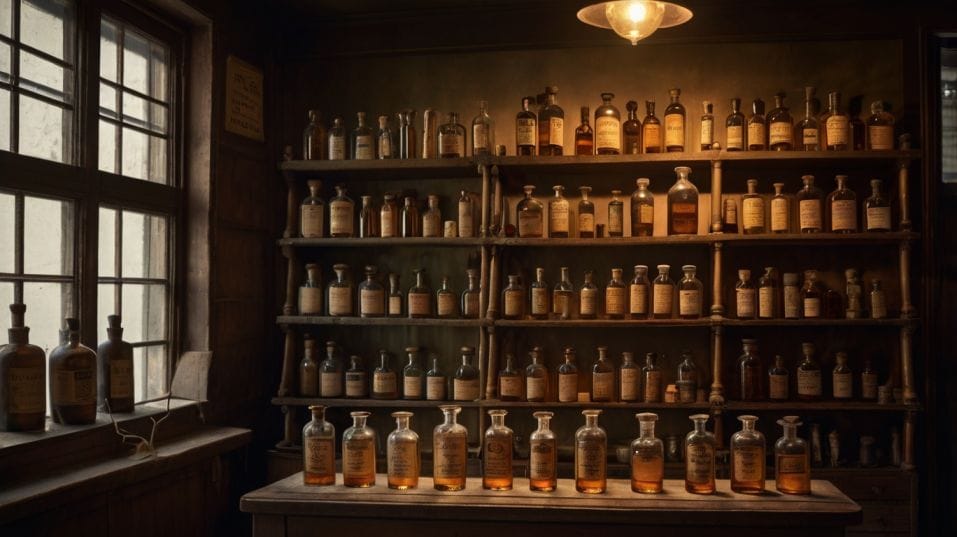Was Whiskey Really Medicine During Prohibition?
Whiskey survived Prohibition as medicine. Learn the loophole that kept it legal—and why it still matters to collectors today.

Did you know whiskey once required a prescription? During Prohibition, you couldn’t legally buy a drink—but you could get “medicinal” whiskey at a pharmacy.
While cheap, dangerous bootlegs flooded the streets, real bourbon and rye survived in amber-labeled bottles behind the counter.
For whiskey newcomers, this strange loophole isn’t just a quirky fact—it’s a key to understanding what makes a great whiskey last. And why some bottles are still worth collecting a century later.
The Real Story Behind “Medicinal” Whiskey
In 1920, the U.S. government passed the Volstead Act, enforcing the 18th Amendment and making alcohol illegal to manufacture, sell, or transport. Except… it didn’t entirely shut the door.
There were exceptions for religious wine, industrial alcohol, and—most curiously—medicinal spirits. Doctors were allowed to write prescriptions for up to one pint of whiskey every ten days.
You could pick it up at your local pharmacy, where it was bottled with a government-issued strip stamp and labeled strictly for “medicinal use.”
Think of it as a federal gray zone: whiskey wasn’t technically outlawed, just repurposed. Not as a drink, but as a cure.
Some doctors and pharmacists resisted. Many more leaned in. Prescription pads became bar tabs. Walgreens expanded from 20 stores to over 500 during Prohibition—not because coughs were spreading faster, but because whiskey was.
Behind the counter, this wasn’t sketchy homebrew. This was bonded bourbon, straight rye, or aged Scotch produced by the same distilleries you know today.
And they weren’t brewing in secret. They were operating under special federal licenses—legal, taxed, and regulated. It wasn’t moonshine. It was survival.

What the Loophole Preserved
Here’s where the story shifts from historical oddity to practical insight. While most spirits disappeared into a haze of black-market stills and basement setups, whiskey stayed on its feet.
Not all of it, of course—hundreds of distilleries folded—but a handful kept their licenses active, kept their barrels aging, and kept quality control alive.
The Role of Licensed Distilleries
Six distilleries, including Brown-Forman and A. Ph. Stitzel, received federal permits to bottle medicinal whiskey. Others sold their remaining stocks to be rebottled under these licenses.
You won’t find flavor profiles on prescription bottles, but what was inside still followed traditional mash bills, aging standards, and bottling techniques.
The Prohibition years quietly protected some of the most essential whiskey principles:
- Aging matters: These weren’t rushed spirits. Even as barrels sat idle, they developed character.
- Mash bill integrity: Rye-heavy whiskeys stayed spicy. Corn-dominant bourbons stayed rich.
- Bottled-in-Bond standards: Though the law didn’t require it for medicinal bottling, many whiskeys adhered to the Bottled-in-Bond Act of 1897—100 proof, aged at least four years, and distilled at a single distillery in a single season.
If you're developing your palate, this is where it starts. Not with gimmicks, but with the basics: grain, age, wood, proof. These whiskeys weren’t made to be trendy—they were made to be right.
Tasting Lessons from a Time of Scarcity
Most people who drank medicinal whiskey didn’t know mash bills from mouthfeel. They wanted to drink legally and avoid poisoned moonshine.
But if you’re here to taste smarter, you can learn from what made medicinal whiskey endure. When supplies are limited, technique becomes everything.
During Prohibition, there was no rush to ship fresh bottles. Some barrels sat aging far longer than they would’ve in a normal market. That extra time mellowed harsh edges, brought out deeper flavors, and let wood and grain integrate more fully.
Today, when you sip a whiskey that claims 10, 12, or 15 years of age, ask yourself: Does that time feel earned?
What to Look for When Tasting
Look for signs of intentional aging:
- Structure: Does the whiskey hold its shape across the palate, or collapse into sweetness or heat?
- Oak balance: Can you taste the barrel influence without feeling overwhelmed by tannin?
- Finish: Does the flavor linger cleanly, or vanish into ethanol?
These aren’t just collector’s questions. They’re the kind of details that separate a casual pour from a confident choice.
The Collector’s Edge: Value vs. Hype
Medicinal whiskey bottles from Prohibition are among the rarest and most sought-after in the world. But if you’re building a collection, don’t chase price tags—chase purpose.
A bottle that survived the Great Depression, federal oversight, and 90+ years of storage doesn’t just have value. It has credibility. And credibility is what you want in your collection, even if you're starting small.
Building a Collection with Staying Power
Look for whiskeys that reflect the same resilience:
- Bottled-in-Bond bourbons that follow tight standards.
- Straight ryes that haven’t been doctored or diluted.
- Independently bottled single malts with clear age and cask transparency.
Ignore trends. Ignore buzzwords. Ask: Would this whiskey have held up in 1925? If it would’ve made the cut then, it deserves a spot now.
Final Thoughts: Respect the History—Drink With Intent
Yes, whiskey was legally sold as medicine during Prohibition. No, it didn’t cure anything—except maybe bad taste and worse decisions.
But the real takeaway is this: in a time when shortcuts were everywhere, whiskey kept its standards. And if you’re serious about learning whiskey—not just buying bottles but understanding what makes them matter—you should do the same.
Start with whiskeys made with intent. Taste slowly. Question everything on the label. Build a shelf that says more than “I bought this”—build one that says, “I chose this.”
Because whiskey isn’t about collecting hype or repeating tasting notes. It’s about clarity. History. Craft.
And sometimes, it’s about knowing that the best whiskey doesn’t need a prescription—just a purpose.
So pour with purpose today. Taste for structure. Collect for story. Build a whiskey life with staying power.




